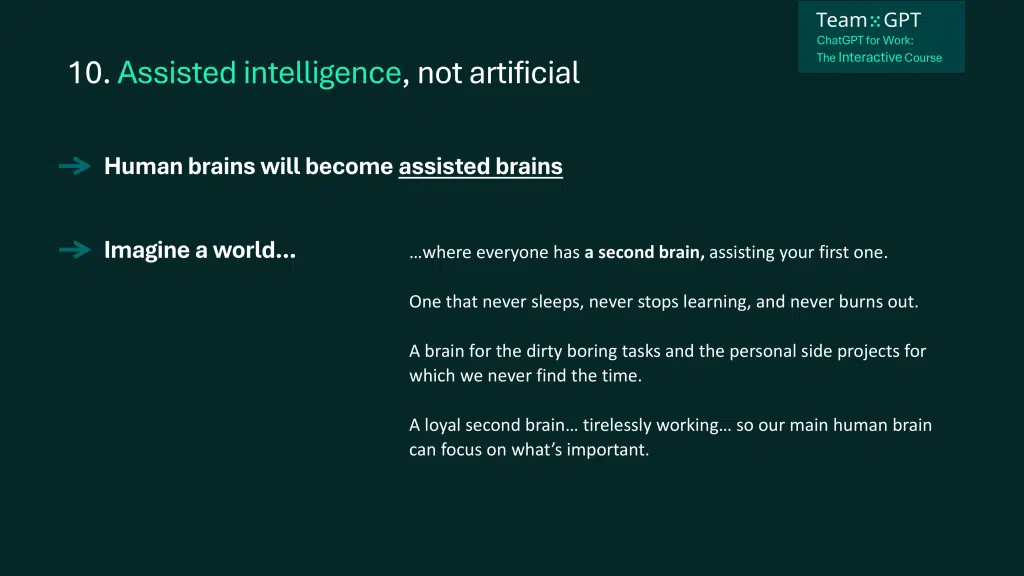LECTURE RESOURCES: Read this lecture in Team-GPT, it is interactive and contains notes and comments from the author.
Table of contents
You cannot have an opinion about ChatGPT before you learn… these 10 things.
I call this: ChatGPT: Bare Minimum.
Here’s the list.
1. What’s ChatGPT?
ChatGPT is an AI model. It’s based on a family of models called GPT, which includes GPT-1, 2, 3, 3.5, and the latest, GPT-4.
ChatGPT is all about conversation. It’s trained on lots of chat data, so it can talk just like a human.
ChatGPT is a type of Large Language Model or LLM. LLMs have been around for a while, but ChatGPT made them popular because of its simplicity.
In just 5 days, ChatGPT drew a million users. Now, it’s used by over 100 million people worldwide.
It is so useful, that once you incorporate ChatGPT in your work, it is hard to imagine life without it.
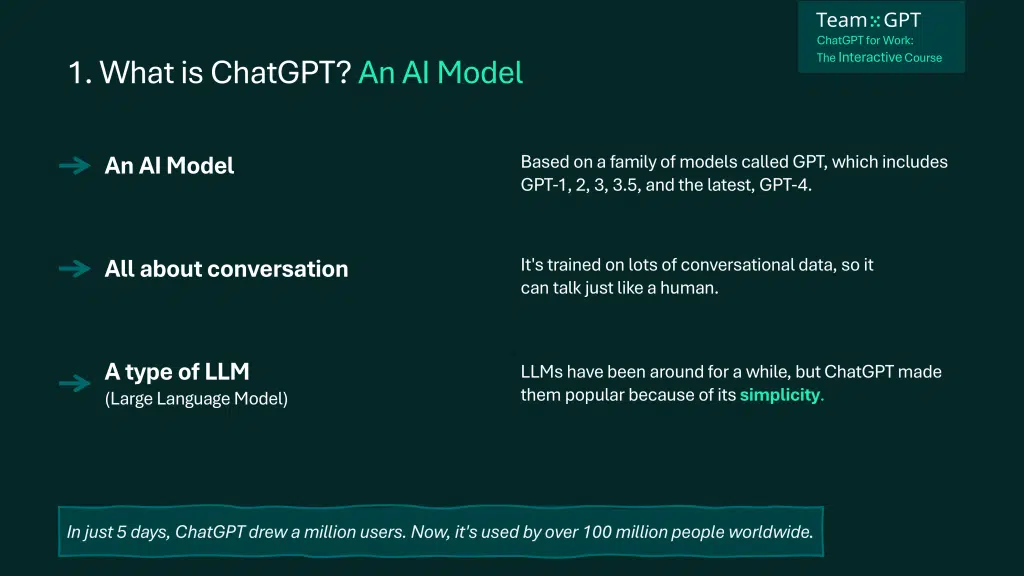
2. Are there others?
ChatGPT is not the only LLM.
Google has its own model called PaLM that you can chat with through the product Google Bard.
There’s more.
Meta also has a model, called LLaMa. LLaMa was open-sourced a couple of years ago, making it easy for anyone on the Internet to build their own LLMs.
Your own LLM?
Yes, it is possible. The easiest way to play around with custom LLMs is on Hugging Face. Hugging Face currently has more than 300,000 models to choose from.
Are they any good?
One thing is for sure: GPT-4 is the best model ever. By far.
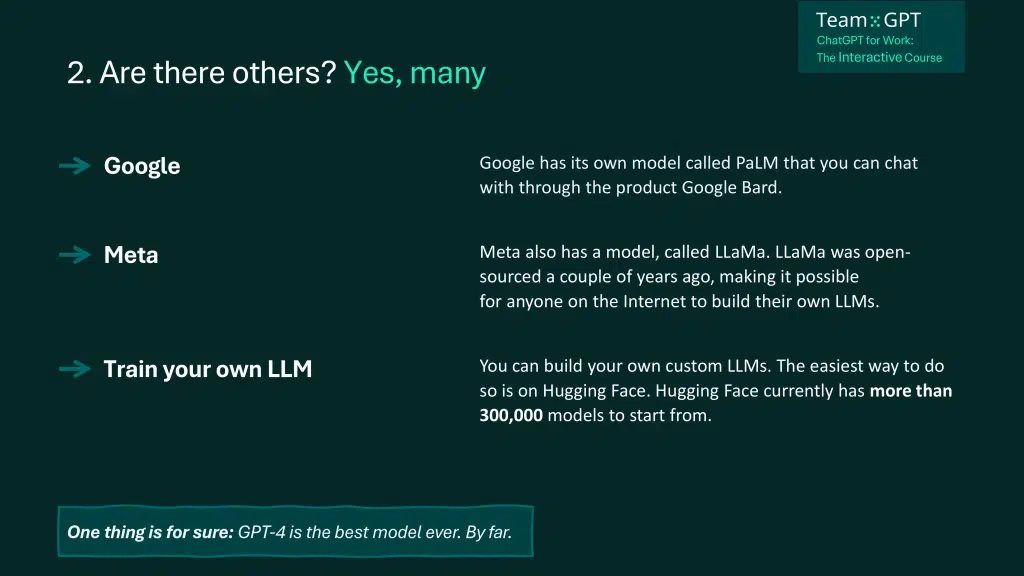
3. Once trained, ChatGPT doesn’t use any data
ChatGPT is trained on lots of information: code, books, articles, and even images.
This training takes months. For instance, GPT-4 took about 10 months to train.
When the training is done, ChatGPT stops learning. It has information up until the latest data it was trained on. In GPT-4’s case that’s 2021.
It is possible to fine-tune LLMs and provide more data after training but that’s a story for a different time.

ChatGPT doesn’t use data from the Internet. In fact, it doesn’t use any data at all. Instead, the model uses very advanced mathematics to generate the text that you see.
You’ve browsed the internet using ChatGPT? Good for you. What you’ve done is the following: you have used Bing for search, and only then the results were summarized by ChatGPT. ChatGPT is not connected to the Internet. Remember this.
A better option for you would be to use Google Bard. It does the same but uses Google under the hood, not Bing. That’s why Bard is so much better than ChatGPT when it comes to search.
Overall, LLMs are nothing but AI models that don’t need any data after they are trained.
Every answer is based on probability, not data.
4. ChatGPT is all about probability
ChatGPT works based on probabilities.
For instance, say you provide the sentence:
Back in high school, me and my friends would often go………. , dot, dot, dot.
And ask GPT to finish it. Without more context, there are thousands of ways to finish this sentence.
Here’s how it works:
Simply speaking, ChatGPT assigns a probability to all the words that exist and decides how to finish the sentence. For instance, here are several words that could follow and their respective probabilities:
Back in high school, me and my friends would often go….
- to school (5.4%)
- hiking (1.4%)
- camping (1.6%)
- to cafés (3.4%)
- microphone (0%)
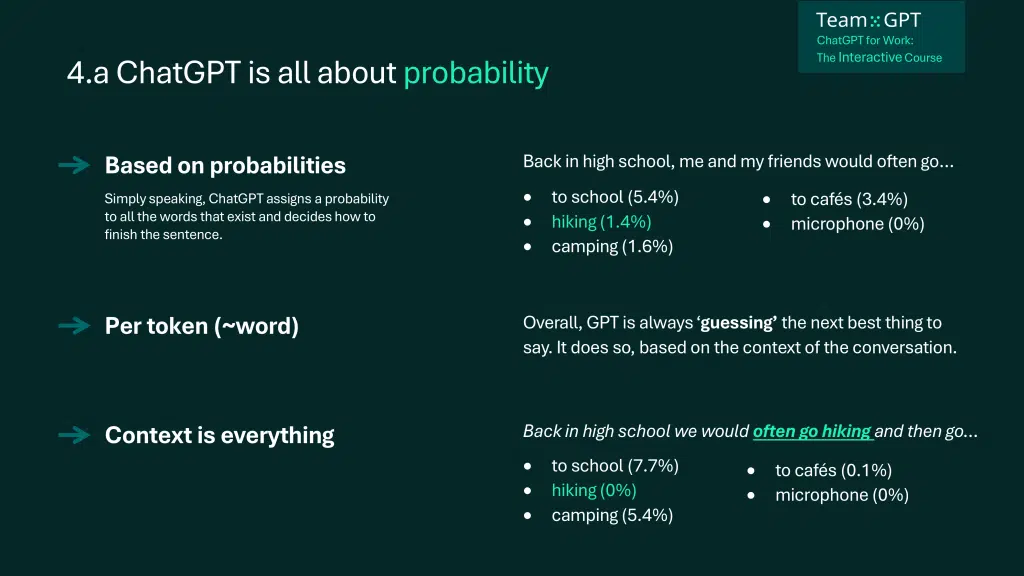
Since ChatGPT doesn’t have any more context, all of these could work. So, it simply chooses one of them.
Words like ‘microphone’ have 0 probability of being said. Like most other words in the English language. They simply won’t work.
Now.
ChatGPT doesn’t calculate the probability of the whole phrase or answer.
It does this for each word (or more specifically: each token).
That’s why when the output of the chat is going out, it is going word by word. Sometimes it looks like GPT is ‘glitching’ or ‘thinking’. In reality, it is calculating and comparing probabilities.
Overall, GPT is always ‘guessing’ the next best thing to say. It does so, based on the context of the conversation.
In our example, if we say: Back in high school we would often go hiking and then go…, we are immediately eliminating ‘hiking’ as an option. It has already been said, so its probability of following fell to practically 0%.
- to school (7.7%)
- hiking (0%)
- camping (5.4%)
- to cafés (0.1%)
- microphone (0%)
The probabilities changed, because of the extra context.
Now that this is clear, let’s zoom out a bit.
Every ChatGPT reply is nothing but a guess. A very well-educated guess, based on most of the text humanity has ever created.
The more information you share, the more you are narrowing down the possibilities for ChatGPT.
You are eliminating some words, while increasing the probability of others.
Just be careful.
ChatGPT is so focused on maximizing the probabilities that it sometimes says things that are not true. ChatGPT cannot fact check, it can only guess. When it starts making stuff up, we say it ‘hallucinates’.
With ChatGPT it always comes down to probability.
So share a lot of details with ChatGPT and… the rest is probability.
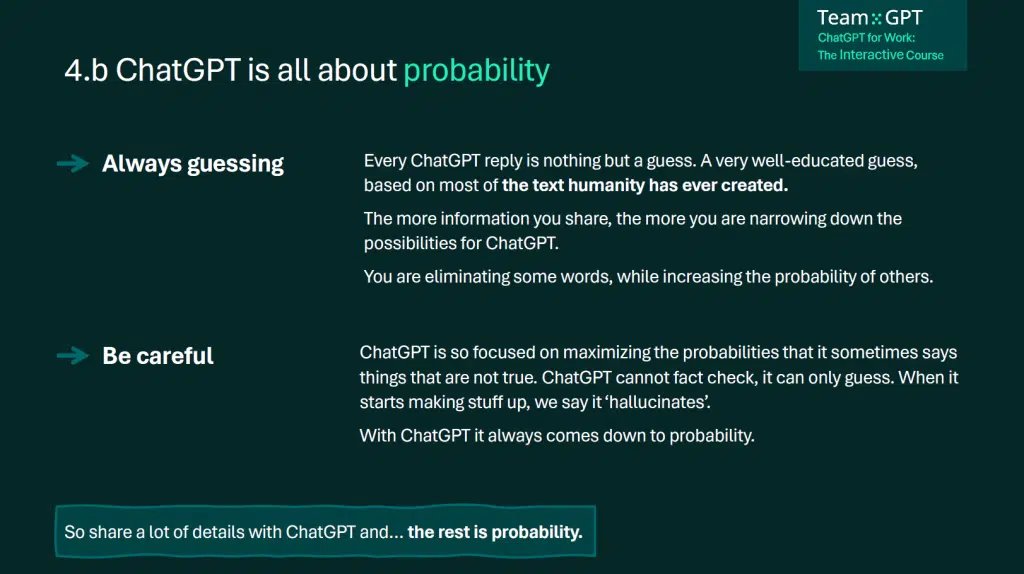
5. Prompt engineering
There are people who are very, very good at chatting with ChatGPT.
They are great at prompting the AI to answer well. These are called prompt engineers. Or lately ChatGPT gurus, AI whisperers, Prompt Magicians, and other.
Prompt engineers are not magical beings. These are people who spent a lot of time talking to the AI and simply… learned how to speak its language.
Anyone can become a prompt engineer by simply following several steps:
- Have 10 high-value conversations with the AI
- Learn a couple of simple tricks (Let’s go through this step by step, ask me clarifying questions, give 5 variations, use less adjectives, etc.)
- And continue asking the AI any question you have, any problem you face, try to test the boundaries of the tool
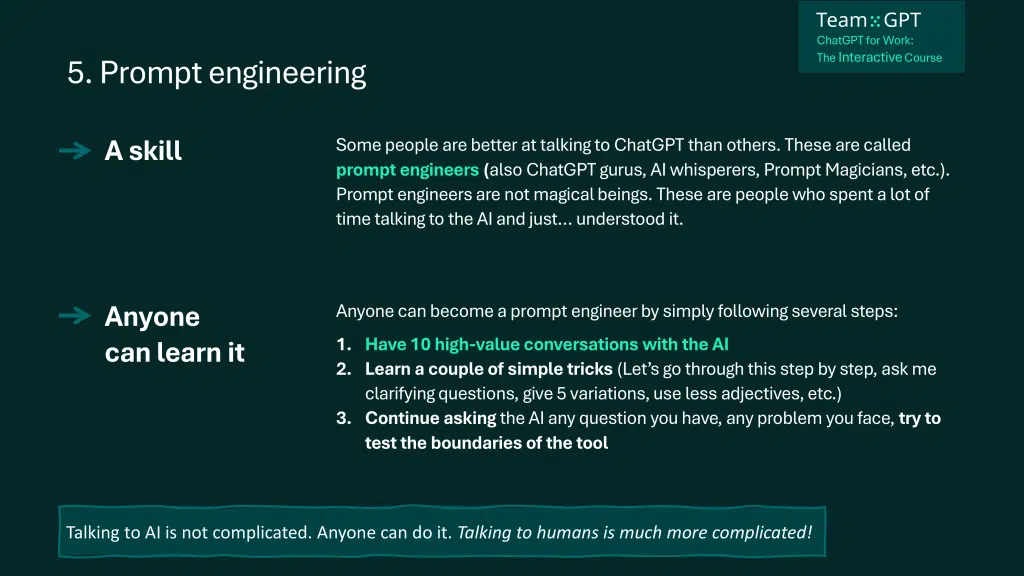
Talking to the AI is not complicated. Anyone can do it.
Talking to humans is much more complicated!
Anyone can become a prompt engineer.
And in just a couple of years, almost every human on Earth will be.
ChatGPT will be like Siri – always in your pocket but it will actually work.
💡 This lesson is a part of the ChatGPT for Work course
The course is interactive, if you take it inside the Team-GPT platform.
ChatGPT for Work: The Interactive Course contains:
• 100+ tried and tested prompts
• 100+ exercises
• 100+ extra notes and comments
• 1000s of use cases
• PDFs files for later reference
It is also completely FREE.
Start today and become a ChatGPT expert in less than 7 days!
6. Limitations and thresholds
AI might seem powerful, but it can’t grow endlessly. It has limits. Here are two big ones:
- Hardware
- Data
AI models, like ChatGPT, are huge. They need lots of servers to run. Big companies and even countries want these servers for their own AI models. But there aren’t enough servers for everyone
AI learns from data. But we’re running out of NEW data.
By 2024, we might have utilized all the GOOD data that exists.
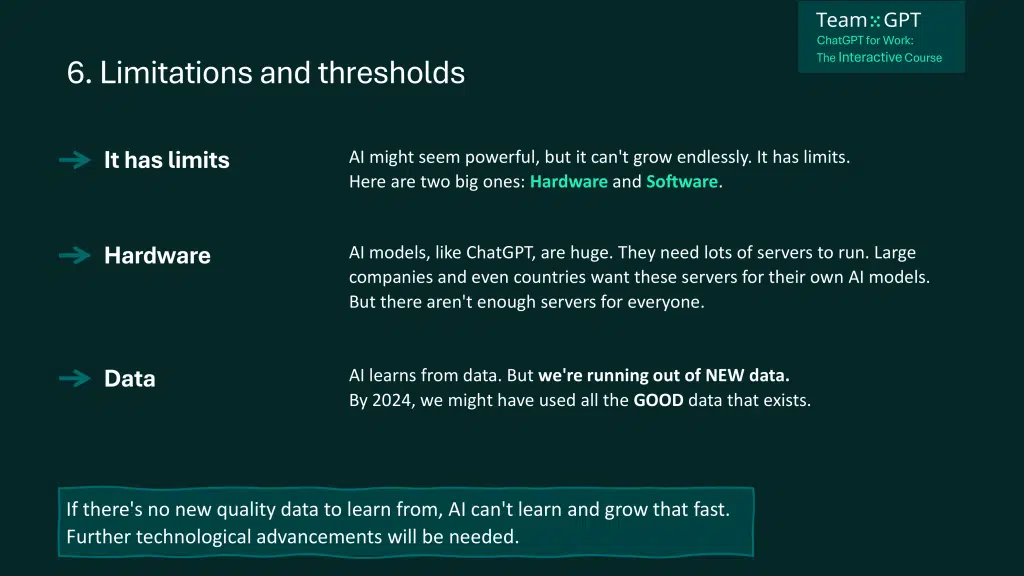
If there’s no new quality data to learn from, AI can’t learn and grow that fast.
Further technological advancements will be required.
7. Use Cases
ChatGPT is useful for a number of use cases and can make many jobs easier.
Whether you’re in management, marketing, customer service, finance, software, or any other job that involves SPEAKING and WRITING, ChatGPT can likely boost your productivity.
It is exceptional at translation, argumentation, ideation, and many more.
But ChatGPT excels in written text, and not numbers.
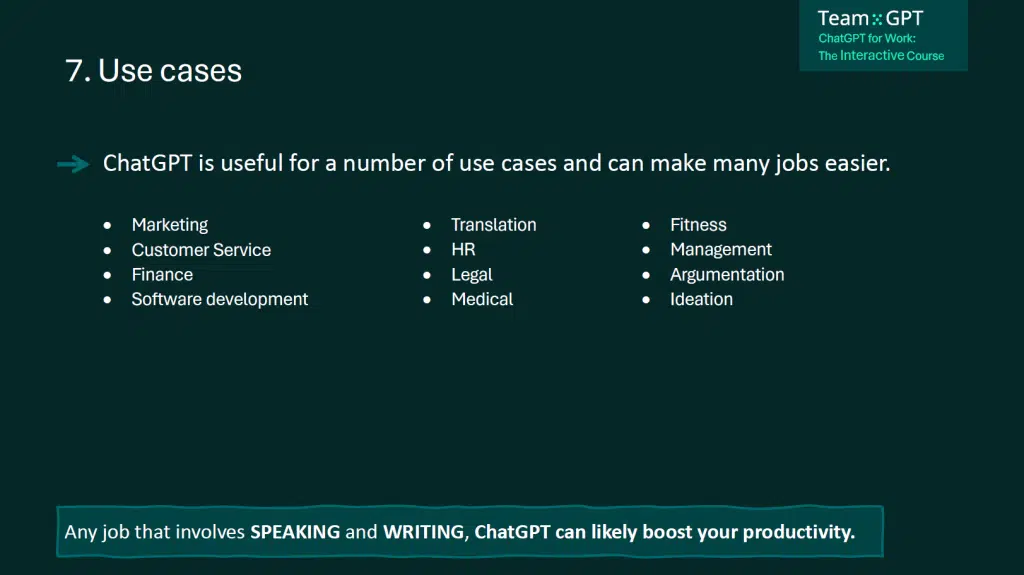
8. Bad with numbers👎
ChatGPT isn’t great with numbers. It might handle simple math, but don’t count on it for complex equations, hard riddles, or logical deduction.
ChatGPT is not a calculator and shouldn’t be used as one.
When you say: 50 times 3, ChatGPT knows it is 150, only because it has seen the text ‘50 times 3 equals 150’ or similar… many, many times.
ChatGPT cannot add, subtract, multiply or divide. It does not do the math.
It is merely guessing. Always guessing.
For text it can get away with it but not with numbers.
For ChatGPT to be ‘correct’, it needs to have seen the same problem countless times before.
Like 1+1 equals 2.
But nothing more.
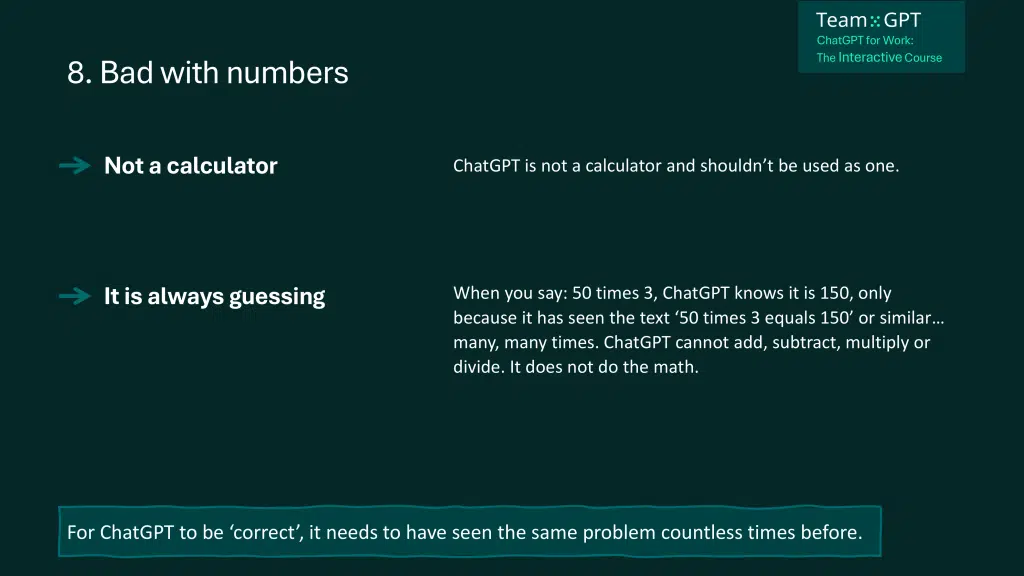
9. Reasoning👍
The fact that ChatGPT is not a Math geek, doesn’t make it stupid. At all.
Prompt it well enough and it will be your best friend, coach, therapist, or personal assistant.
Bear in mind, it may not always provide great output, but that’s usually due to your bad prompting.
And in fact, when the output is good, it’s often better than most humans.
In a work environment, ChatGPT often provides extremely good answers to business decisions and can help in the decision-making process of many people.
Don’t believe me? Just ask ChatGPT ‘I’m going to do X. Try to explore the pros and cons of this decision.’
This is a prime example of how ChatGPT assists us to be better at everything we ask it.
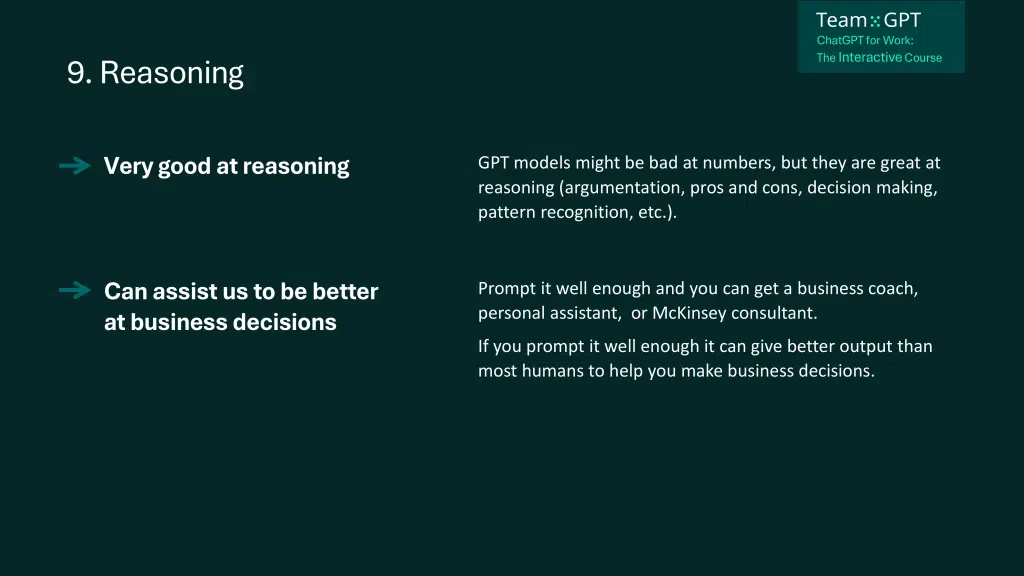
10. 🖖Assisted Intelligence, not Artificial
Human brains will become assisted brains.
Imagine for a moment a world where you have a second brain.
One that never sleeps, never stops learning, never burns out.
A brain for the dirty boring tasks, the most complex questions, and even the personal side projects for which we never find the time.
A loyal second brain… tirelessly working… so your human brain can focus on whatever brings you joy.
Wouldn’t you like that?
